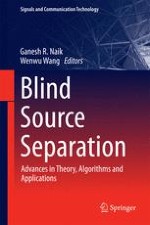2014 | OriginalPaper | Chapter
12. On the Ideal Ratio Mask as the Goal of Computational Auditory Scene Analysis
Authors : Christopher Hummersone, Toby Stokes, Tim Brookes
Published in: Blind Source Separation
Publisher: Springer Berlin Heidelberg
Activate our intelligent search to find suitable subject content or patents.
Select sections of text to find matching patents with Artificial Intelligence. powered by
Select sections of text to find additional relevant content using AI-assisted search. powered by
